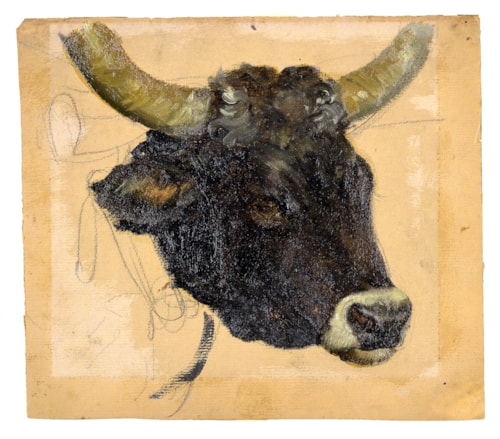
Constant TROYON
Sèvres 1810 - Paris 1865
Biography
The son of a painter at the Sèvres porcelain factory, where he began his career as an apprentice, Constant Troyon received his early artistic training with the landscape painters Jean-Victor Bertin and Camille Roqueplan. It was Roqueplan who introduced Troyon to the Barbizon painters Jules Dupré, Théodore Rousseau and Narcisse Diaz de la Peña , all of whom were to have an influence on the young artist’s style. Troyon exhibited for the first time at the Salon in 1833, showing landscape paintings, and in later years won medals at the Salons of 1838, 1840, 1846 and 1859. Of particular importance was a trip Troyon made to Holland in 1847-1848, where he was impressed with the work of such 17th century Dutch artists as Aelbert Cuyp and Paulus Potter, whose 1647 painting The Young Bull in the Mauritshuis he copied. It was as a result of this visit to the Netherlands that Troyon moved from pure landscape painting to animal subjects, with a particular emphasis on cattle. Indeed, Troyon’s contemporary reputation rested largely on his undoubted skills as an animal painter, and he was established as one of the foremost animalier artists in France. Exhibited throughout Europe, Troyon’s paintings achieved very high prices and were acquired by collectors in France, England and America. He was awarded the Legion of Honour in 1849, and earned a first class medal at the Exposition Universelle of 1855. Nor did his reputation dim after his death in 1865, and he reached the height of his posthumous fame throughout the 1890s and the first decades or so of the 20th century. Paintings by Troyon are in numerous public collections, including the Louvre and the Wallace Collection.
As one modern scholar has noted, ‘Troyon’s cattle pictures are remarkable for their anatomical accuracy; for he took great pains and made numerous studies of cattle and other domestic animals. He was, in fact, an accomplished draughtsman, and even in his later works, many of which were rapidly executed, we are aware of the sound draughtsmanship and the accumulation of knowledge of the structure not only of cattle and other animals but also of landscape, that he could always call upon.’ However, only a handful of preparatory drawings by Troyon for his paintings are known.



